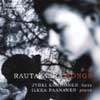Rautavaara Songs
A revelatory disc of songs by the cult Finn
View record and artist detailsRecord and Artist Details
Composer or Director: Einojuhani Rautavaara
Genre:
Vocal
Label: BIS
Magazine Review Date: 2/2004
Media Format: CD or Download
Media Runtime: 80
Mastering:
Stereo
DDD
Catalogue Number: BIS-CD1141

Tracks:
| Composition | Artist Credit |
|---|---|
| (3) Sonnets |
Einojuhani Rautavaara, Composer
Einojuhani Rautavaara, Composer Ilkka Paananen, Piano Jyrki Korhonen, Bass |
| (Die) Liebenden |
Einojuhani Rautavaara, Composer
Einojuhani Rautavaara, Composer Ilkka Paananen, Piano Jyrki Korhonen, Bass |
| Maailman uneen (Dream World) |
Einojuhani Rautavaara, Composer
Einojuhani Rautavaara, Composer Ilkka Paananen, Piano Jyrki Korhonen, Bass |
| I min älsklings trädgård |
Einojuhani Rautavaara, Composer
Einojuhani Rautavaara, Composer Ilkka Paananen, Piano Jyrki Korhonen, Bass |
| God's Way, 'Guds väg' |
Einojuhani Rautavaara, Composer
Einojuhani Rautavaara, Composer Ilkka Paananen, Piano Jyrki Korhonen, Bass |
| (5) Orpheus Sonnets |
Einojuhani Rautavaara, Composer
Einojuhani Rautavaara, Composer Ilkka Paananen, Piano Jyrki Korhonen, Bass |
| Pyhiä päiviä (Sacred Feast) |
Einojuhani Rautavaara, Composer
Einojuhani Rautavaara, Composer Ilkka Paananen, Piano Jyrki Korhonen, Bass |
| Matka (The Trip) |
Einojuhani Rautavaara, Composer
Einojuhani Rautavaara, Composer Ilkka Paananen, Piano Jyrki Korhonen, Bass |
Author: Guy Rickards
The monochrome medium of Lieder, for many music-lovers still something of an acquired taste, is not one automatically associated with Rautavaara. Those who respond to the broad, multi-faceted canvases of Vigilia or the Fifth or Angel of Light Symphonies might shy away from almost 80 minutes of basso profundo songs with piano, even when they are as gloriously sung as they are here by Jyrki Korhonen, for whom the composer specially adapted them.
And that would be a pity because this recital is also gloriously accompanied and recorded and the songs themselves are rich and diverse. Despite Rautavaara’s stylistically varied compositional career, the fundamental guiding principle in these songs – spanning the years 1951 to 1987 (though the second song of Dream World was revised in 1997) – is lyricism and, yes, tunefulness. The cast of the melody in the delightful first number, ‘In the Great Wild Woodlands’ of In My Lover’s Garden (1983-87) might almost be by Sibelius, even though the accompaniment gently reminds us that this is music from a later time.
The sets collectively include texts in Finnish, English, Swedish and German, from writers including Shakespeare, Rilke and the composer himself. This serves to underline just what a very fine word-setter Rautavaara is – listen to the early Shakespeare (1951-52) or Rilke Sonnets (1954-55) for page after page of eloquent testimony to that. The musical language varies from set to set, mostly due to verbal rather than formalistic demands, although it can be no accident that the severity of Die Liebenden (1958-59) came when it did, as the 30-year-old Rautavaara was mining the potential of serialism. The two Rilke cycles serve as preparation for the culminating The Trip (1977), an extraordinary refraction in music of a journey through New York at night.
In general, the harmonic language of these songs is not severe, tonal rather (albeit in a form expanded from simple diatonicism). The songs show, much as his music does in any other medium, Rautavaara’s genius as a communicator. A rewarding issue, then, excellently produced, with notes by the composer.
And that would be a pity because this recital is also gloriously accompanied and recorded and the songs themselves are rich and diverse. Despite Rautavaara’s stylistically varied compositional career, the fundamental guiding principle in these songs – spanning the years 1951 to 1987 (though the second song of Dream World was revised in 1997) – is lyricism and, yes, tunefulness. The cast of the melody in the delightful first number, ‘In the Great Wild Woodlands’ of In My Lover’s Garden (1983-87) might almost be by Sibelius, even though the accompaniment gently reminds us that this is music from a later time.
The sets collectively include texts in Finnish, English, Swedish and German, from writers including Shakespeare, Rilke and the composer himself. This serves to underline just what a very fine word-setter Rautavaara is – listen to the early Shakespeare (1951-52) or Rilke Sonnets (1954-55) for page after page of eloquent testimony to that. The musical language varies from set to set, mostly due to verbal rather than formalistic demands, although it can be no accident that the severity of Die Liebenden (1958-59) came when it did, as the 30-year-old Rautavaara was mining the potential of serialism. The two Rilke cycles serve as preparation for the culminating The Trip (1977), an extraordinary refraction in music of a journey through New York at night.
In general, the harmonic language of these songs is not severe, tonal rather (albeit in a form expanded from simple diatonicism). The songs show, much as his music does in any other medium, Rautavaara’s genius as a communicator. A rewarding issue, then, excellently produced, with notes by the composer.
Discover the world's largest classical music catalogue with Presto Music.

Gramophone Digital Club
- Digital Edition
- Digital Archive
- Reviews Database
- Full website access
From £8.75 / month
Subscribe
Gramophone Full Club
- Print Edition
- Digital Edition
- Digital Archive
- Reviews Database
- Full website access
From £11.00 / month
Subscribe
If you are a library, university or other organisation that would be interested in an institutional subscription to Gramophone please click here for further information.




